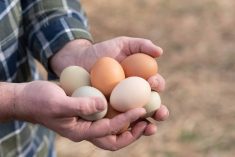In my last column, I looked at the pros and cons of building a brand for your farm operation offered by Ben Graham, who is the president of AdFarm and whose family has been farming the same land near Vulcan, Alta., for 117 years. Graham makes a strong case for creating a brand for your farm no matter its size or what you produce. And he offered six key steps to build an on-farm brand to his farmer audience at Farm Forum Event last November.
Read Also

Gentle treatments for pain in the neck
Heading toward year-end, people unknowingly tense up against the cold and busyness, causing neck pain that can often be treated with appropriate support and gentle mobility, athletic therapist Kathlyn Hossack says.
The first step is to create a statement of who you are. And it’s important to personalize the statement as best you can. For example, a statement like, “We’re a proud, fifth-generation farm focused on producing high-quality grains in a sustainable family environment,” could be a statement for a grain farmer anywhere in the country, says Graham.
Tying the statement to a specific geography like the Peace River region, Great Plains, or Red River Valley, for example, would personalize it. Also, nuances about your family would help, such as adding your farm is a “sibling-run operation,” says Graham. Additionally, clearly define “success” or “positioning” words to your statement like best, leading, highest, etc., he adds.
The second step is to develop a logo — and a logo is needed. It will be used across social media channels, on your website (we’ll talk about that next), on your business cards, on your farm sign, or wherever else you can use it. There are many websites and resources available to help you create a logo for your brand.
The third step is to create a website if you do not already have one. “In this day and age, (a website) is mandatory,” says Graham. “If you’re going to create a brand of any kind and you want to control and enhance the perception of your brand, a website is a key tool. It doesn’t have to send a ship to the moon, but it needs to be really solid, easy to navigate, clear and have lots of images.”
Your website will allow you to define your operation’s story, what you stand for, what you produce and how you produce it. To the website add images and video of the family, the farm operation and the pillars of your operation. The website will let people learn more about you and your operation.
Graham says it’s also important for the website to be open and for people to be able to interact with it and you. Answering questions people visiting your website ask you is one way to do this.
For those farmers who think the time commitment may be too large, Graham suggests enlisting help. “A lot of farmers will say, ‘I don’t have time to answer 10 questions a week on my website,’ and that’s what it’ll be — it won’t be much more than that. The reality is there should be kids in high school or a niece, nephew or grandkids who can help with that. Answering those questions can make it a more engaging environment.”
You may also worry that creating a website will leave you, your operation or your website open to criticism or attack. This isn’t the case, says Graham. “People are worried they’re going to get spammed by special interest groups that hate agriculture. It doesn’t happen. I haven’t heard any of that in (anything) we’ve been involved in and (neither have) any of my cohorts in the business. It very rarely happens, (and if it does) it’ll happen to large corporations, not very often to a farm family.”
Participating in social media is “super” important and is the fourth key step for successful branding of your farm operation. Platforms such as Instagram, Facebook, Twitter and LinkedIn are “where conversation is happening and where content can be shared,” says Graham. Understanding social media and how to position and talk about your farm operation using these platforms are important, says Graham. However, if using social media just isn’t your thing, once again, help can be enlisted.
“If you’re a 65-year-old farmer who doesn’t really want to be in the social channels, find somebody who does. You can probably hire somebody (who is) fairly cost effective in your local community. It doesn’t have to cost a lot of money. We’re really finding that learning and understanding how to use those tools is really important to the operation.”
Once you have decided to join and engage in social media, build a strategy around it, taking into consideration what you are going to say and when you’re going to say it. Work with the seasonality of the business of running a farm. For example, at harvest, post lots of harvest images — take photos on the combine, of sunrises and sunsets, of the family dog, of dinners in the field, etc., suggests Graham.
“Pick some stuff that you really enjoy, that you’re passionate about, during harvest. Inform (people) how the crops are looking. All those types of things are important. It’s the same with spring and winter — what’s going on during those times of year and what you’re doing on your operation.
“Also, what’s going on in your community? It’s a great way to support that. Figure out your strategy for social media. It doesn’t have to be rocket science. You don’t have to do it every day. You (can post) a couple of times per month, it doesn’t have to be onerous and it doesn’t take a lot of time — and it’ll really be a key part of your brand,” he says.
The fifth step on your road to building your brand is identify a community relations or outreach plan. We are all involved with our communities in one way or another and building your brand in your community is important. This can be done in many ways. Some farm operations have engaged with the local community by holding open farm days or giving tours of their farms to school groups. Other farm operations are donating money or time to local charities and events. And these efforts are becoming a crucial component to farm operations. “It’s becoming as important as marketing your grain on a grain farm or marketing your livestock,” says Graham.
The sixth step on Graham’s brand-building list is to have a presence on YouTube. Again, it doesn’t have to be a big production that eats up a lot of time — it could be a short video recorded with your smartphone of you talking about who you are, what you produce and why, and what it means to you and your family. “Set the (smartphone) on the hood of your truck and talk a little bit about your operation and post it — it’s super easy to do. And, again, there’ll be a grandkid, niece, nephew, son or daughter who will help get that happening for you. Don’t be intimidated and don’t run away from it — it’s so important.”
There really is a lot to share with people about your farms. People who do not live on farms will find most daily tasks interesting. Share your triumphs, hardships and, even, frustrations — like a machinery breakdown. “We are one of the best content opportunities for a story in the world, in any business. We have families, we have pets, we have livestock. There’s so much we have access to for a story. You’ll be surprised at how many people will be interested in the fact that you had three healthy calves this afternoon, or late last night — or that you had to pull a calf at three in the morning and it was -22 C. Those are things that may seem mundane and just daily occurrences for us in agriculture. They’re important to onlookers and people who have decided to engage with you.”
I know this to be true as I spend a lot of time on YouTube watching things just like that. If you are thinking about branding your farm operation and these steps feel a little steep, remember, you can take it slow and look at one little piece at a time.
If you are embarking on a branding adventure, please let me know at [email protected]. I would love to learn about your operation and follow how branding your farm is coming along.
Stay well,
Kari
















